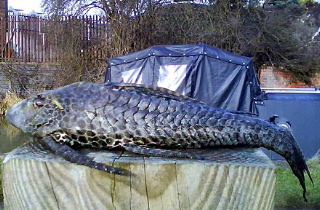
March 27, 2009
Breaking news out of the UK for March 27, 2009, at first would have you believe that a new coelacanth had been found. The prehistoric creature (above) with scaly skin similar to a crocodile and an impressive set of teeth, was found or hooked, already dead, by schoolboy fisherman Shawn (also spelled “Shaun” in some news accounts) Brown, 14, in the Grand Union Canal at Wigston in Leicestershire.
The youthful Brown said: “I thought it was some sort of monster fish at first. I could see its teeth which looked menacing. It had a really hard back and an ugly look on its face.’
His father Alan, 45, a service engineer, added: “I was really excited. I usually catch perch and pike but this was really amazing. It blew me away.”
The 14-year-old took a picture of his 10 inches-long discovery and showed it to a number of aquarists who managed to name it.
This fish has been identified as an armored suckermouth catfish (Hypostomus plecostomus), which can grow up to 2 ft long, is a herbivore and uses its distinctive mouth to draw up algae from rocks. Its tough scales act as a defense mechanism to ward off predators. They live in the wild in Panama, Costa Rica and South America.
In some places in the southern US (e.g. Florida and Texas), this species has been introduced from its native range, probably dumped by aquarists into the local waters. For example, they are present in a lake in the neighborhood of Hammock Trace Preserve in Melbourne, Florida. They also have been introduced to several Asian countries as well, and in the Philippines, it is now considered a pest in areas in and around the Laguna de Bay. Suckermouth catfish are often cultured in ponds in Singapore and Hong Kong, where it is very popular for the aquarium trade.
Often called plecos after their Latin name Hypostomus plecostomus, some species can live out of water for up to 30 hours. It is also called commonly referred to as Plecostomus by some aquarists. In the Philippines, in the aquarium trade, it is called the janitor fish. It is often purchased for its ability to clean algae from fish tanks and aquarium rocks.
Experts say it is the first time an armored suckermouth catfish has been found in the waterways of the United Kingdom.
It is thought to have been released into the canal after growing too big for somebody’s aquarium but could not survive in the colder water. They pose no threat to humans although it is not known what effect they would have on native fish if they were to ever breed in the UK.
John Hall, who runs All Seasons Angling tackle shop in Wigston, said: “We are only 300 yards from where Shawn found it and he came in here and showed me the photo. He is a good little fisherman and as soon as he saw it knew it didn’t belong here. He went home and looked it up on the internet to try and see what it was but he had to send it off to experts to identify it. It had teeth as well and I’m sure it was scare a lot of anglers who saw it swimming up river. But it looks worse than it actually is.”
Ian Wellby, a fisheries scientist at Brooksby College, Leics, said: “It is not something you want in your freshwaters but it is quite harmless. It is the first one I have ever heard of in Britain before. It is a warm water fish and could not survive our winters.”
In one of the more bizarre statements that drifted into this account, is this quote from the UK papers: “Experts say it is unlikely to have migrated here because of global warming.”
Realistically and unfortunately for the fish involved, this was not a coelacanth-like discovery but probably only a rather dramatic case of an unloved pet fish being thrown in a nearby ditch.

Sources: Telegraph. Daily Mail, Wikipedia.
About Loren Coleman
Loren Coleman is one of the world’s leading cryptozoologists, some say “the” leading living cryptozoologist. Certainly, he is acknowledged as the current living American researcher and writer who has most popularized cryptozoology in the late 20th and early 21st centuries.
Starting his fieldwork and investigations in 1960, after traveling and trekking extensively in pursuit of cryptozoological mysteries, Coleman began writing to share his experiences in 1969. An honorary member of Ivan T. Sanderson’s Society for the Investigation of the Unexplained in the 1970s, Coleman has been bestowed with similar honorary memberships of the North Idaho College Cryptozoology Club in 1983, and in subsequent years, that of the British Columbia Scientific Cryptozoology Club, CryptoSafari International, and other international organizations. He was also a Life Member and Benefactor of the International Society of Cryptozoology (now-defunct).
Loren Coleman’s daily blog, as a member of the Cryptomundo Team, served as an ongoing avenue of communication for the ever-growing body of cryptozoo news from 2005 through 2013. He returned as an infrequent contributor beginning Halloween week of 2015.
Coleman is the founder in 2003, and current director of the International Cryptozoology Museum in Portland, Maine.
Filed under Breaking News, Cryptotourism, CryptoZoo News, Living Fossils, Megafauna, Out of Place, Weird Animal News